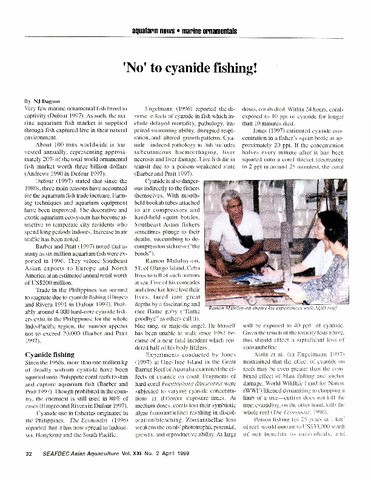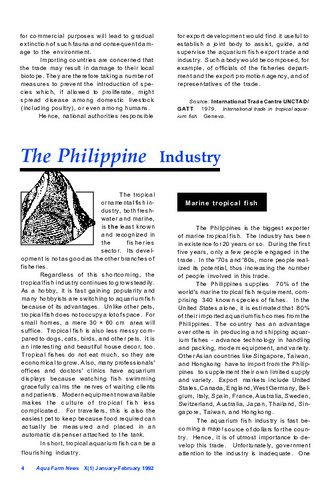Detection and identification of aquatic Mycobacterium species in fish, fish farm workers and the environment
| dc.contributor.author | Puttinaowarat, Suppalak | |
| dc.contributor.author | Thompson, Kim D. | |
| dc.contributor.author | Somsiri, Temdoung | |
| dc.contributor.author | Kolk, Arend H. J. | |
| dc.contributor.author | Kullavanijaya, Preeya | |
| dc.contributor.author | Adams, Alexandra | |
| dc.contributor.editor | Lavilla-Pitogo, Celia R. | |
| dc.contributor.editor | Cruz-Lacierda, Erlinda R. | |
| dc.date.accessioned | 2021-10-22T06:15:16Z | |
| dc.date.available | 2021-10-22T06:15:16Z | |
| dc.date.issued | 2002 | |
| dc.identifier.citation | Puttinaowarat, S., Thompson, K. D., Somsiri, T., Kolk, A. H. J., Kullavanijaya, P., & Adams, A. (2002). Detection and identification of aquatic Mycobacterium species in fish, fish farm workers and the environment. In C. R. Lavilla-Pitogo & E. R. Cruz-Lacierda (Eds.), Diseases in Asian aquaculture IV: Proceedings of the Fourth Symposium on Diseases in Asian Aquaculture, 22-26 November 1999, Cebu City, Philippines (pp. 243-256). Fish Health Section, Asian Fisheries Society. | en |
| dc.identifier.isbn | 9718020160 | |
| dc.identifier.uri | http://hdl.handle.net/10862/6214 | |
| dc.description.abstract | Mycobacteriosis, caused by Mycobacterium spp, is a common disease in snakehead (Channa striata) and Siamese fighting fish (Betta splendens). In Thailand, snakehead is an economically important food species, while Siamese fighting fish is one of the main ornamental species cultured for export. Mycobacteriosis is not confined to fish and can also be transmitted to humans. M. marinum has been reported to be the main species involved in mycobacteriosis in both fish and man. The results from this study showed that M. fortuitum as well as M. marinum, is involved in Mycobacterium infections observed on Siamese fighting fish and snakehead fish farms. Both M. fortuitum and M. marinum were detected in samples collected from the fish s environment, including water and fish food, although M. fortuitum appeared to be the more prevalent of the two species. However, a large number of the Mycobacterium spp. detected in the samples collected from the farms remains unspeciated. Workers on the Siamese fighting fish farms were affected by skin lesions, while those on snakehead fish farms were not unaffected. When biopsies of the lesions were analysed by polymerase chain reaction and reverse cross blot hybridisation, M. fortuitum together with unspeciated Mycobacterium sp. appeared to be the main aetiological agents associated with the lesions. | en |
| dc.publisher | Fish Health Section, Asian Fisheries Society | en |
| dc.subject | Mycobacterium | en |
| dc.subject | Channa striata | en |
| dc.subject | Betta splendens | en |
| dc.title | Detection and identification of aquatic Mycobacterium species in fish, fish farm workers and the environment | en |
| dc.type | Conference paper | en |
| dc.citation.spage | 243 | en |
| dc.citation.epage | 256 | en |
| dc.citation.conferenceTitle | Diseases in Asian aquaculture IV: Proceedings of the Fourth Symposium on Diseases in Asian Aquaculture, 22-26 November 1999, Cebu City, Philippines | en |
| dc.subject.asfa | fish | en |
| dc.subject.asfa | fishers | en |
| dc.subject.asfa | fish culture | en |
| dc.subject.asfa | surveys | en |
| dc.subject.asfa | samples | en |
| dc.subject.asfa | DNA | en |
| dc.subject.asfa | polymerase chain reaction | en |
| dc.subject.asfa | hybridization | en |
| dc.subject.scientificName | Mycobacterium marinum | en |
| dc.subject.scientificName | Mycobacterium fortuitum | en |
Files in this item
| Files | ขนาด | รูป | View |
|---|---|---|---|
|
There are no files associated with this item. |
|||
รายการนี้ปรากฏใน (s)
-
Diseases in Asian aquaculture IV [43]
Proceedings of the Fourth Symposium on Diseases in Asian Aquaculture, 22-26 November 1999, Cebu City, Philippines




